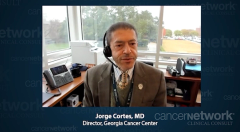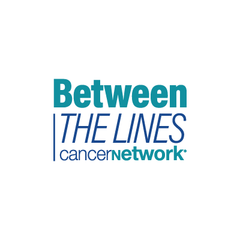
Future Implications for Use of Ponatinib
Experts review future implications such as using ponatinib in earlier lines of therapy and in patients with Ph-positive ALL.
Episodes in this series

Transcript:
Hagop Kantarjian, MD: An important question, Jorge, that we need to address is what are the future implications? One issue is to try to move ponatinib to earlier phases. Should we do a study of ponatinib in salvage 1 [first salvage therapy] in patients who have failed frontline, second-generation TKIs [tyrosine kinase inhibitors] with resistance, not toxicity? What happens in the community practice is you have a patient who is on a second-generation TKI, say nilotinib, dasatinib, or bosutinib, and they fail because of resistance. And then the investigators or the community oncologists start rotating those second-generation TKIs, even though there are no guiding mutations. It’s a waste of time. If the patients fail because of toxicity, then you can rotate the second-generation TKIs. But if they fail because of resistance, the first salvage therapy that would be most effective would probably be ponatinib. We have to get the data out and/or potentially do a randomized study in salvage 1 in patients who have received second-generation TKIs as frontline therapy and failed because of resistance. The control could be physician’s choice, such as another second-generation TKI or perhaps a newer third-generation TKI, vs ponatinib.
The other implication is in Philadelphia [chromosome]-positive ALL [acute lymphoblastic leukemia] because there’s no doubt. We’re doing studies with ponatinib and chemotherapy, and ponatinib with blinatumomab in Philadelphia-positive ALL. There’s no doubt that the 45-mg dose can be toxic. In the initial experience of hyper-CVAD [hyperfractionated cyclophosphamide, vincristine, doxorubicin, and dexamethasone] and ponatinib, we had 2 deaths from arterial occlusive event. That’s why we lowered the dose of ponatinib to 30 mg. You could argue that these patients don’t have a T315I mutation at diagnosis, so 30 mg may be good enough for them. The implication is significant not only in chronic myeloid leukemia, but also for the Philadelphia-positive ALL, where again, I would favor starting with 30 mg rather than 45 mg daily. What are you doing in Philadelphia-positive ALL today, Jorge?
Jorge E. Cortes, MD: I’m going to quickly mention one thing about the survival. And I’ll stop there because we don’t want to spend the whole hour talking about this. Remember, we’ve shown way back then that even patients who haven’t achieved a complete cytogenetic response derive a survival benefit if they have some sort of response. Even hematologic, it’s not as good, but there is some survival benefit. That is part of the reason why we’re still seeing some survival benefit there. Now that points out the fact that this is a good drug no matter what dose you use.
On using it earlier, absolutely. This area of second-line therapy after a second-generation TKI, I see it as a great unmet need. If you remember we had that study way back then, and unfortunately it was at the time when all these issues came of toxicity. We were only able to enroll 5 patients, and we had to stop the study. All 5 patients did well. None of them had toxicities, but it’s only 5 patients. Rotating from one second-generation TKI to another second-generation to another second-generation, you’re doing it because you have them, but not because it benefits the patients. The anecdotal experience, because all we have are case series, it’s not good. It doesn’t give them the level of response that you see with ponatinib, not anywhere close to that. I agree, now that we’ve understood ponatinib better, the safety profile and how to manage it, that has to be brought back because it’s by far the best strategy that you have for those patients. It’s not a small number of patients who fail because of resistance to second-generation TKIs. Most patients respond, but there is a good fraction of patients, a good 25% to 30% of patients, who fail because of resistance.
In terms of Philadelphia-positive ALL, I think that starting there with a lower dose makes sense. Among other things, they are getting chemotherapy, so it’s not the same context. You’re using the combination of drugs. And hyper-CVAD is pretty good in terms of getting it in remission. Almost everybody gets a remission with chemotherapy. You can’t maintain it with chemotherapy, but everybody does that. So doing that is good. That strategy of lowering the dose after you get into remission, if anything, you can say it was pioneered there, because that’s how it started. It started initially with 45 mg; when these issues became recognized, 30 mg. Once the patients went in remission, the dose was starting to be lowered, and it turned it safer. In Philadelphia-positive ALL, starting with a lower dose and even then lowering it further once the patient achieves a response, it’s the same strategy. Now I would take it further. This strategy of an induction dose followed by a lower maintenance dose should be the way to go in most of the settings with tyrosine kinase inhibitors in general. Do we need to keep every patient with frontline nilotinib at 300 mg twice a day, or dasatinib at the standard of 100 mg but even using 50 mg? Once they respond, do you need to maintain those doses? Can you lower the dose they maintain? When we’ve looked back at patients who dose-reduced because of toxicity, we’ve seen that they maintain their responses anyway. Should we be more proactive and using these TKIs in that fashion, starting with 1 dose and lowering it once they respond? I think that’s a strategy that should be expanded into other settings.
Transcript edited for clarity.
Newsletter
Stay up to date on recent advances in the multidisciplinary approach to cancer.























































































